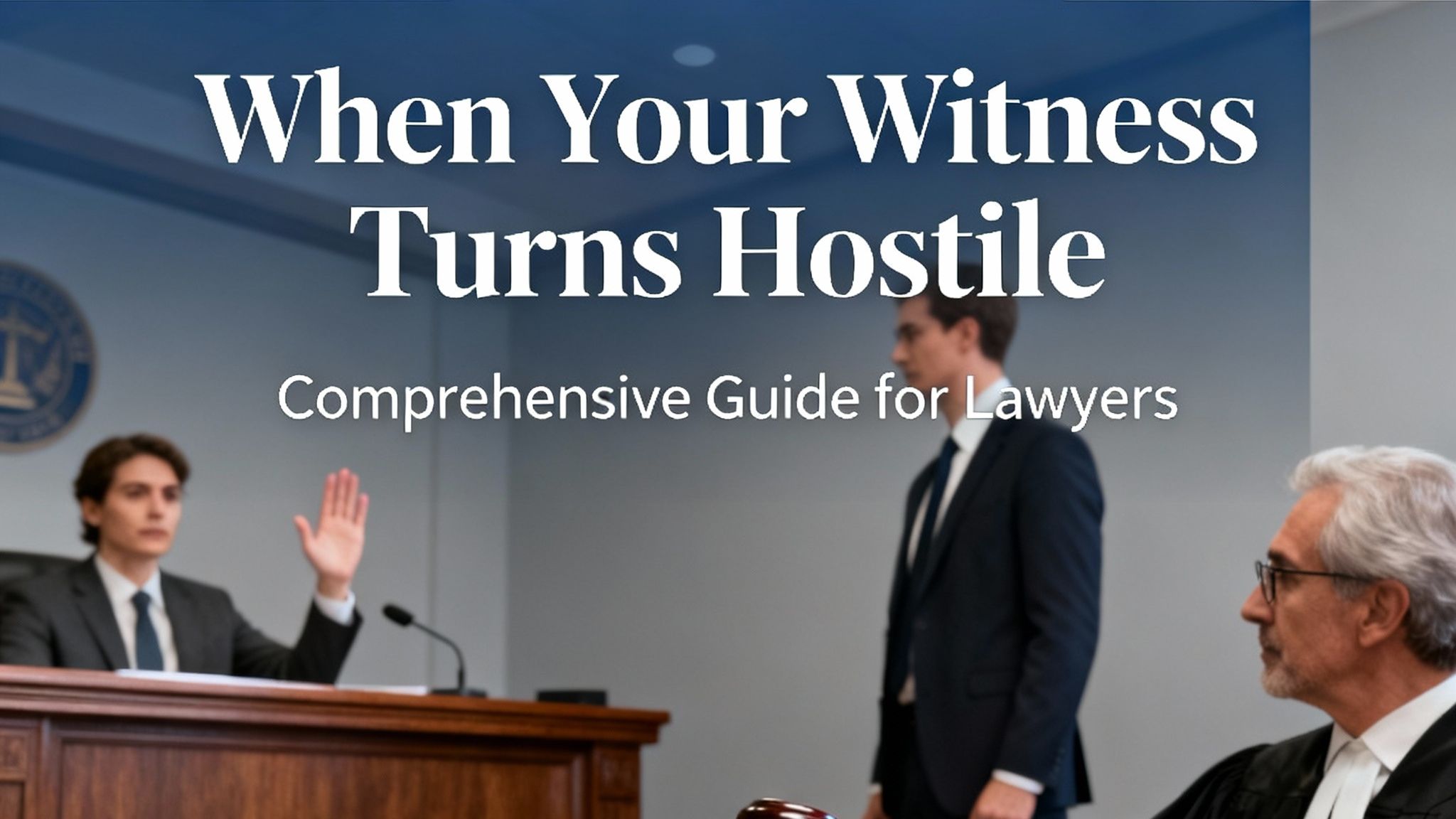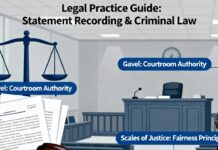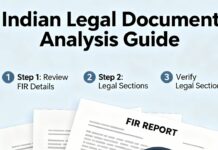What to Do When Your Witness Turns Hostile: A Comprehensive Guide for Lawyers
When a witness whose testimony is crucial to your case suddenly contradicts their earlier statement and turns against you in court, it can feel like a devastating blow. However, hostile witnesses are not uncommon in the Indian criminal justice system, and experienced lawyers know that this challenge, while serious, is not insurmountable. Understanding the legal framework, procedural requirements, and strategic options available can help you navigate this complex situation effectively.

Hostile Witness Legal Proceedings Thumbnail
The phenomenon of witnesses turning hostile has reached alarming proportions in India, with the Supreme Court noting that “if a witness turns hostile for extenuating reasons and is reluctant to depose the unvarnished truth, it will cause irreversible damage to the administration of justice”. Recent data suggests that witness hostility contributes significantly to the low conviction rates in serious criminal cases, making it imperative for legal practitioners to master the art of handling such situations.[1]
Understanding the Legal Framework
Definition and Distinction: Hostile vs. Unfavorable Witnesses
The concept of a hostile witness, while not explicitly defined in Indian statutes, has been extensively clarified through judicial precedents. The Supreme Court in Sat Paul v. Delhi Administration established the fundamental distinction: a hostile witness is one who is unwilling to tell the truth at the instance of the party who has called him, whereas an unfavorable witness is one who, instead of proving a particular fact, fails to prove such fact or proves an opposite fact.[2][3][4]
This distinction is crucial for practitioners. As the Court emphasized in R.K. Dey v. State of Orissa, “if the witness is speaking the truth and his testimony goes against the interest of the party who has called him, then he cannot be necessarily called hostile”. A witness’s primary obligation is to speak the truth, not to show allegiance to the party who summoned them.[3]
Section 154 of the Indian Evidence Act: The Statutory Foundation
Section 154 of the Evidence Act provides the legal mechanism for dealing with hostile witnesses. It states: “The Court may, in its discretion, permit the person who calls a witness to put any questions to him which might be put in cross-examination by the adverse party.” This provision grants courts discretionary power to allow a party to cross-examine their own witness when hostility is demonstrated.[2][5][6][7]
The application of Section 154 is subject to specific conditions established through case law. In G.S. Bakshi v. State, the Court held that “the answers and the attitude of the witness are the major factors from which the hostility of the witness can be construed”. The witness must exhibit hostility through deliberately making statements contrary to what he stated earlier or what he is expected to prove.[3][5][6]

Legal Procedure and Strategic Framework for Handling Hostile Witnesses in Indian Criminal Law
Procedural Requirements for Declaration of Hostility
Timing and Application Process
The declaration of a witness as hostile must be made immediately during the examination process. In Jatinder Singh Bhatia v. State and Others, the Court held that “declaration of a witness as hostile is to be done immediately at the time of examination of witness and cannot be permitted to be done after witness has been examined”.[8]
The procedure requires the examining party to formally request the court to declare the witness hostile. This application must be supported by specific evidence demonstrating the witness’s hostility, such as contradictions with previous statements recorded under Section 161 or Section 164 of the CrPC.[2][5][6][9]
Court’s Discretionary Power
The court’s power under Section 154 is entirely discretionary and must be exercised judicially. The permission cannot be granted without cause or reason. The court must be satisfied that the witness is not speaking the truth or is deliberately concealing facts.[5][6]
Recent Supreme Court guidance emphasizes that the discretion should be exercised keeping in mind the interests of justice and the need to elicit truth. Courts cannot act suo motu but must respond to applications from the examining party with proper justification.[10]
Strategic Response Framework
Immediate Assessment and Documentation
When you suspect a witness is turning hostile, immediate documentation is crucial. Maintain detailed notes comparing the witness’s court testimony with their earlier statements under Section 161 CrPC or Section 164 CrPC. The contradictions must be specific and material to the case.[9][11]
Watch for behavioral indicators of hostility: evasive answers, reluctance to answer directly, nervous demeanor suggesting coaching, or complete denial of previously recorded statements. Document these observations as they will support your application to declare the witness hostile.
Cross-Examination Techniques Under Section 154
Once the court permits cross-examination of your own witness, you gain access to several powerful tools:
1. Leading Questions (Section 143): You can now ask leading questions that suggest their own answers, allowing you to control the witness’s responses and limit damaging testimony.[12][13]
2. Confrontation with Previous Statements (Section 145): This is your primary weapon against hostile witnesses. You can confront the witness with their exact words from police statements or magistrate recordings. The Supreme Court in recent 2025 judgments has clarified that for contradictions to be effective, strict compliance with Section 145 is required.[9][11]
3. Character Impeachment (Section 146): You may attack the witness’s credibility by questioning their character, though this must be done carefully within legal bounds.[13][12]
4. Credit Impeachment (Section 155): This allows you to challenge the witness’s credibility through various means, including proof of bribery or corrupt inducement.[12][13]
Evidentiary Value and Judicial Approach
Treatment of Hostile Witness Testimony
The testimony of a hostile witness is not automatically rejected. The Supreme Court has consistently held that “merely because the witnesses turn hostile does not necessarily mean that their evidence has to be thrown out entirely, and what is supportive of the prosecution can certainly be used”.[2][14][10]
In the recent 2025 case of Goverdhan v. State of Chhattisgarh, the Supreme Court reiterated that hostile witness testimony should be evaluated for parts that corroborate other prosecution evidence. The Court emphasized that “even though a witness resiles from his previous incriminating statement, the portions corroborated by other evidence remain relevant”.[10]
Corroboration Requirements
While hostile witness testimony can support conviction, courts generally seek corroborating evidence. The Supreme Court in K.P. Tamilmaran v. State (2025) held that “if part of the evidence of a hostile witness corroborates with other reliable evidence, then that part of the evidence is admissible”.[14][8]
The key principle is that the court must examine, test, and corroborate hostile witness testimony before relying on it for conviction. This requirement provides opportunities for defense counsel to challenge the reliability of such testimony.[14]
Contemporary Challenges and Solutions
Reasons for Witness Hostility
The Supreme Court in Ramesh v. State of Haryana identified seven primary reasons why witnesses turn hostile:[15][1]
- Threat and intimidation by accused parties
- Inducement through various means (financial or otherwise)
- Use of muscle and money power by accused
- Employment of stock witnesses
- Protracted trial delays
- Harassment during investigation and trial
- Non-existence of clear legislative mechanisms to check hostility
Understanding these causes helps lawyers develop preventive strategies and identify when hostility may be due to external pressure rather than genuine change of heart.
Witness Protection Measures
The Bharatiya Nagarik Suraksha Sanhita (BNSS) 2023 has significantly strengthened witness protection through Section 398. This provision mandates every state government to prepare and notify a Witness Protection Scheme. The scheme categorizes witnesses into three groups based on threat perception: Category A (life threat), Category B (safety/reputation threat), and Category C (moderate harassment).[16][17]
The Delhi Witness Protection Scheme 2025 provides specific protections including identity concealment, relocation, security equipment installation, and video conferencing facilities. Lawyers should actively advocate for witness protection when intimidation is suspected.[18]
Technology Integration
The Electronic Evidence and Video Conferencing Rules 2025 allow examination of witnesses through video conferencing. This is particularly valuable for protecting vulnerable witnesses from intimidation. The new provisions ensure that witnesses can testify without being physically present in the same room as the accused.[19][20][21]
Recent judicial guidelines emphasize that video conferencing does not compromise the principle of orality if proper safeguards are maintained. Courts have authorized this method specifically to prevent witness intimidation and ensure truthful testimony.[19]
Alternative Strategies and Evidence Sources
Documentary and Forensic Evidence
When key witnesses turn hostile, shift focus to documentary evidence, forensic analysis, and technical proof. Electronic evidence, CCTV footage, call detail records, and digital communications often prove more reliable than witness testimony.
The Supreme Court has emphasized that non-recovery of weapons or physical evidence does not invalidate reliable circumstantial evidence. Build your case on multiple evidence sources rather than depending solely on witness testimony.[10]
Dying Declarations and Hearsay Exceptions
Section 32 of the Evidence Act allows dying declarations as substantive evidence. Recent Supreme Court judgments emphasize that a dying declaration “enjoys almost a sacrosanct status, as a piece of evidence, coming as it does from the mouth of the deceased”.[22][23][24]
If your primary witness becomes unavailable due to hostility or intimidation, dying declarations can provide crucial evidence. The Court has held that dying declarations can form the sole basis for conviction if they inspire confidence and are free from tutoring or prompting.[23][24]
Expert Witness Utilization
Expert witnesses are generally less susceptible to intimidation and can provide technical analysis that supports your case. Medical experts, forensic specialists, and technical analysts can often substitute for lay witnesses in proving crucial facts.[25][26]
When cross-examining opposing experts, focus on their methodology, qualifications, and potential bias. The Sargon test requires experts to base opinions on reliable evidence rather than speculation.[26][25]
Perjury and Legal Consequences
Section 193 IPC/Section 231 BNS: False Evidence
Hostile witnesses who deliberately give false testimony can be prosecuted for perjury under Section 193 IPC (now Section 231 BNS). The punishment extends up to seven years imprisonment for giving false evidence in judicial proceedings.[27][28]
However, the Supreme Court has clarified that mere inconsistency in statements does not automatically constitute perjury. The prosecution must prove intentional falsehood, and perjury proceedings should only be initiated when expedient in the interests of justice.[29][27]
Witness Intimidation Provisions
Section 195A IPC (now Section 232 BNS) criminalizes witness intimidation with punishment up to seven years. Recent amendments have strengthened these provisions, making witness intimidation a serious cognizable offense.[15][30][31]
Lawyers should immediately document suspected intimidation and file complaints under these provisions. This serves dual purposes: protecting the witness and preserving evidence of external interference with the judicial process.
Best Practices and Prevention Strategies
Pre-Trial Preparation
Comprehensive witness preparation is the best defense against hostility. Maintain detailed documentation of all witness interactions, record statements when possible, and establish multiple corroborating sources. The new Electronic Evidence Rules 2025 facilitate video recording of witness statements for later use.
Regular communication with prosecution witnesses helps identify potential problems early. Witnesses who feel supported and protected are less likely to turn hostile.[32]
Case Management Strategies
Don’t rely on single critical witnesses. Build networks of backup witnesses and develop multiple lines of evidence. Physical evidence, electronic records, and forensic analysis provide more stable foundations than witness testimony alone.
When hostile witnesses are anticipated, prepare alternative theories of the case that don’t depend on their cooperation. This strategic flexibility allows you to adapt when testimony becomes unfavorable.[10]
Conclusion and Practical Recommendations
The challenge of hostile witnesses in Indian criminal law requires sophisticated legal strategy, thorough preparation, and adaptive courtroom tactics. While the problem of witness hostility remains a significant challenge to the criminal justice system, recent legislative developments under BNSS 2023, enhanced witness protection measures, and evolving judicial precedents provide lawyers with more tools than ever before.
The key to success lies in preparation, documentation, and strategic flexibility. Understanding that hostile witness testimony is not automatically rejected, but rather subject to judicial evaluation for corroborated portions, allows for more nuanced case strategies. The Supreme Court’s recent emphasis on liberal evidence evaluation, combined with strengthened witness protection mechanisms, creates opportunities for securing justice even when primary witnesses turn hostile.
Modern legal practice must integrate technology, comprehensive evidence gathering, and proactive witness protection to address the contemporary challenges of hostile witnesses. By mastering these techniques and staying current with evolving jurisprudence, legal practitioners can effectively serve their clients and contribute to the integrity of the criminal justice system.
- https://api.sci.gov.in/supremecourt/2025/30475/30475_2025_6_1_63887_Judgement_02-Sep-2025.pdf
- https://lawbhoomi.com/section-154-of-the-indian-evidence-act/
- https://blog.ipleaders.in/hostile-witness-laws-across-the-world/
- https://www.delhilawacademy.com/sc-hostile-witnesses-case/
- https://ili.ac.in/pdf/shabnam.pdf
- https://www.galgotiasuniversity.edu.in/pdfs/7-Hostile-Witness-Foe-Or-Victim-Siddhi-Vhora-27218.pdf
- https://www.indiacode.nic.in/show-data?actid=AC_CEN_3_20_00034_187201_1523268871700§ionId=38963§ionno=154&orderno=172
- https://www.criminallawjournal.org/article/60/3-2-2-853.pdf
- https://webapi.sci.gov.in/supremecourt/2021/26995/26995_2021_7_1501_52845_Judgement_03-May-2024.pdf
- https://www.24law.in/story/hostile-witness-testimony-need-not-be-discarded-entirely-supreme-court
- https://www.lawweb.in/2025/08/contradictions-are-not-evidence-supreme.html
- https://www.nacdl.org/getattachment/fada47e0-4eb1-4a28-8ee3-166234331eb4/cross-examination-of-difficult-witnesses.pdf
- https://bprd.nic.in/uploads/pdf/201608240419044682521Report.pdf
- https://www.scobserver.in/supreme-court-observer-law-reports-scolr/k-p-tamilmaran-v-statereliance-on-corroborated-statements-by-hostile-witnesses/
- https://cjp.org.in/factsheet-on-witness-protection-in-india/
- https://bprd.nic.in/uploads/pdf/202402200805128576713WitnessProtectionScheme.pdf
- https://bprd.nic.in/uploads/pdf/202401250116351486103WitnessProtectionScheme.pdf
- https://thc.nic.in/Central Governmental Schemes/Delhi Witness Protection Scheme 2025.pdf
- https://nliulawreview.nliu.ac.in/blog/from-courtroom-to-screen-upholding-orality-and-protecting-vulnerable-witnesses-in-india/
- https://api.sci.gov.in/supremecourt/2016/34388/34388_2016_3_1501_10737_Judgement_05-Dec-2018.pdf
- https://delhihighcourt.nic.in/files/2025-07/citizen-charter/ee_vc_2025.pdf
- https://www.defactojudiciary.in/notes/dying-declaration-under-evidence-act
- http://student.manupatra.com/Academic/Abk/Law-of-Evidence/Chapter4.htm
- https://api.sci.gov.in/supremecourt/2011/35509/35509_2011_5_101_36125_Judgement_02-Jun-2022.pdf
- https://sdinnofcourt.com/five-essential-considerations-for-expert-witnesses/
- https://law.temple.edu/aer/2017/03/22/confronting-opposing-expert-goals-strategies-part-2/
- https://cjp.org.in/wp-content/uploads/2017/05/hostilewitness.pdf
- https://devgan.in/ipc/section/193/
- https://www.livelaw.in/top-stories/supreme-court-193-ipc-inconsistency-in-statement-perjury-prosecution-178785
- https://bprd.nic.in/uploads/pdf/202401290405146446118WitnessProtectionScheme.pdf
- https://www.dehradunlawreview.com/wp-content/uploads/2025/03/2.pdf
- https://www.lawjournals.net/assets/archives/2024/vol6issue4/6137.pdf
- http://student.manupatra.com/Academic/Abk/Law-of-Evidence/chapter10.htm
- https://www.tnsja.tn.gov.in/article/08 A K A Rahmaan THE CROSS EXAMINATION AND ROLE OF COURTS corrected.pdf
- https://cdnbbsr.s3waas.gov.in/s37a68443f5c80d181c42967cd71612af1/uploads/2025/03/202503191256598730.pdf
- https://www.lloydlawcollege.edu.in/blog/how-to-cross-examine-effectively.html
- https://www.advocatekhoj.com/library/lawreports/evidenceact1872/182.php?Title=Review+of+the+Indian+Evidence+Act
- https://www.scconline.com/blog/post/2021/10/15/perjury-proceedings-for-hostile-witness/
- https://www.law.uh.edu/blakely/story-telling/19 – The Five Question Rule-Cross Exam Simplified.pdf
- https://www.writinglaw.com/hostile-witness/
- https://en.wikipedia.org/wiki/Hostile_witness
- https://www.lexisnexis.com/community/insights/legal/b/thought-leadership/posts/five-steps-to-an-effective-cross-examination
- https://www.lawteacher.net/free-law-essays/criminal-law/hostile-witnesses.php
- https://bpasjournals.com/library-science/index.php/journal/article/view/794
- https://www.suniv.ac.in/NAAC/Criteria-3/3.4.7_4.3.5_E-content/3.4.7_4.3.5 Dr. MeenaKetan Sir WItness Protection.pdf
- https://www.alec.co.in/judgement-page/renuka-prasad-v-the-state-2025-sc-559
- https://lc2.du.ac.in/DJCL4/7. Dr. Monica Chaudhary.pdf
- https://www.youtube.com/watch?v=9WcZ0MnKln4
- https://www.lawfinderlive.com/Articles-1/Article36.htm
- https://api.sci.gov.in/supremecourt/2010/9622/9622_2010_3_1501_58346_Judgement_09-Jan-2025.pdf
- https://sandalawoffices.com/law-of-perjury/
- https://advocaterampalsingh.com/if-witness-turns-hostile/
- https://www.torgancooperaaron.com/direct-examination-of-a-hostile-witne/
- http://delhihighcourt.nic.in/files/Notifications and Practice Directions/19435722616763e87d3ed75.pdf
- https://wbja.nic.in/pages/view/129/143-supreme-court-judgments-on-evidentiary-issues
- https://nja.gov.in/Concluded_Programmes/2022-23/P-1335 Programme Report.pdf
- https://supremetoday.ai/issue/Dying-declaration-cannot-be-considered-hostile-suicide
- https://www.ali-cle.org/course/Handling-the-Hostile-Witness-Effective-Techniques-to-Turn-T-VCGI0320
- https://www.humanrightsinitiative.org/download/1619586831Disconnected Videoconferencing And Fair Trial Rights.pdf
- https://lawbeat.in/supreme-court-judgments/eyewitness-not-vital-in-mact-cases-if-fir-charge-sheet-filed-sc-1400780
- https://www.casemine.com/judgement/in/5cde090c4a9326400f17d6e4
- https://www.lawweb.in/2025/05/bombay-hc-whether-motor-accident-claim.html
- https://delhihighcourt.nic.in/app/showFileJudgment/67909092025BA39092024_192456.pdf
- https://www.drishtijudiciary.com/to-the-point/bharatiya-nagarik-suraksha-sanhita-&-code-of-criminal-procedure/witness-protection-scheme
- https://mphc.gov.in/upload/indore/MPHCIND/2023/MA/6776/MA_6776_2023_FinalOrder_13-08-2025.pdf
- https://api.sci.gov.in/supremecourt/2024/35119/35119_2024_16_1502_62602_Judgement_23-Jul-2025.pdf
- https://hcs.gov.in/hcs/hg_orders/201300000082024_7.pdf
- https://www.livelaw.in/tags/hostile-witness
- https://www.lawjournals.net/assets/archives/2025/vol7issue3/7086.pdf
- https://delhihighcourt.nic.in/app/showFileJudgment/59030042025MACA452021_120402.pdf
- https://api.sci.gov.in/supremecourt/2024/56191/56191_2024_13_1501_63783_Judgement_01-Sep-2025.pdf
- https://www.indiacode.nic.in/bitstream/123456789/20062/1/a2023-45.pdf
- https://ppl-ai-code-interpreter-files.s3.amazonaws.com/web/direct-files/c5d86ae470010934663a3a160d4ba72f/153dfe20-dfad-43ca-b2e3-de1a71639e0c/080271be.csv

















